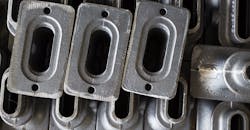Casting surface defects seem to come and go regardless of what the gating specialist may accomplish, or what standards the foundry’s QC depart may change or tighten. Casting surface defects may be gaseous, or they may contain precipitated solid material, but generally such defects fall beyond normal quality-control efforts. Some very capable foundries were at a loss to lower scrap rates until they were exposed to some new control techniques.
Determining defect characteristics – whether gaseous or solid material filled – is easy. The difficulty is to determine the cause, and then determining how to eliminate it is even more difficult. Many good tools are available to lower surface defects rates. Microscopic and SEM analysis can be used; Guesswork must be eliminated.
Knowing the defect cause, however, does not remove it: Learning the technology to counter the defect is needed. In almost all instances, surface defects in iron castings are caused by free-oxygen atoms in the molten iron prior.
Knowing the oxide composition is helpful but knowing how to rid the molten iron of free-oxygen atoms is the bread-winner.
All molten iron contains some amount of free oxygen and any amount above the inert concentration level produces oxides, which creates the potential for surface defect formation. In the end, oxide floatation defects become a portion of every foundry’s casting scrap accumulation.
Casting scrap results from oxide floatation – first forming as nano-sized oxide molecules, then agglomerating into larger masses – until eventually the mass attains buoyancy and floats to the casting surface. Small amounts of oxides may stay suspended, remaining nano-sized, and these act as thickeners within the melt.
Suspended oxides also degrade the iron’s strength and ductility when solidified. The suspended oxides form deleterious crack-initiation sites upon solidification, and then behave similar to carbide in ductile iron -- though the overall affect is much less severe than carbide contamination.
Deoxidized iron significantly improves ductility, and elongation increases have been reported as “never achieved that level in ductility”. Tensile and yield strength also improve: In cast iron, tensile strength increases 15% with deoxidation.
The suspended oxides harm the iron’s fluidity, too. The volume of suspended oxides within a given heat can be determined by determining the overall oxygen content. The reading obtained will show both the oxides present and any free-oxygen atoms within the iron matrix. But the free-oxygen level is minute compared to the overall oxide level present. This makes the oxygen content, which is referred to as “metal cleanliness,” a very important measure of metal quality.
Establishing metal cleanliness ratings for iron heats prior to casting is another “next step” in changing iron casting. Metal cleanliness prejudges the iron’s quality: its fluidity, its scrap forming tendencies, its mechanical strength, its deoxidation state, and its need for annealing heat-treatment to attain elongation requirements.
Deoxidation of the molten iron during the melt process is the only solution to defect-free iron castings. Only iron containing inert levels of free oxygen, iron which has been deoxidized during or after the melting process completes, will be defect-free.
Once oxygen atoms are available within the melt, the oxidation of elemental atoms occurs. Oxidation cannot be stopped and can be prevented only by controlling the free-oxygen atom supply.
The oxidation process affecting molten iron is ongoing until solidification. The reactants are nano-sized atoms and molecules that are unrestricted and unaffected by mechanical filtration. The fact is, if free oxygen is present within the molten iron, defects will always form. The level of free oxygen in the melt determines the severity of the defects formed.
Surface defects can come and go. Their appearance is significantly affected by atmospheric humidity. High humidity favors rapid iron oxide formation in molten iron. Hot, humid summer days raise defect-formation rates by many magnitudes.
Stopping surface defects goes together with deoxidation, and the means to accomplish that is readily available. DeOX Metal Treatment is the only simple method to eliminate oxides completely and to retard their formation. In steel casting, additives like aluminum, calcium, and others are added to tie-up free oxygen atoms. But in iron, the levels of aluminum to counter oxygen, produce hydrogen gas sensitivity which disqualifies its use.
DeOX Metal Treatment includes adding small amounts of deoxidizing material during melting, which counters iron-oxide generation, chemically reducing existing iron oxide and instantly countering new oxide formation.
Establishing a metal cleanliness rating for your casting heats takes the guesswork out of tracking surface-defect formation, casting fluidity, metal strength and ductility, the need for annealing heat treatment, machinability, and overall casting quality.
Ron Beyerstedt is the president of Mastermelt LLC. Contact him at [email protected]
About the Author
Ron Beyerstedt
Ron Beyerstedt is the president of Mastermelt LLC. Contact him at [email protected]
